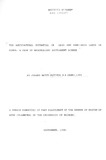| dc.description.abstract | This study set out to analyze the agricultural potential in
a newly settled Masongaleni Settlement Scheme being an example
of an Arid and Semi-Arid land. The potentials here are the
under-utilized rainfed, irrigated agriculture and livestock
production particularly bee keeping. A comparison of selected
rainfed crop yields from Masongaleni Settlement Scheme and
similar ~cological areas is used to identify the potentials of
the &chem~.
On the irrigated crops, the study compares the farmers'
incomes from rainfed ~ash crops and the incomes that may be
realised from selected irrigated crops. The irrigated crops
earn the farmer much' higher incomes as compared to the rainfed
crops. The new improved bee keeping method is identified as
untapped potential in the livestock sector. The study compares
the new improved bee keeping method to the traditional method
and finds that the new method is better.
The study identifies the major constraints to the tapping
of these potentials. Opportunities, strategies and solutions to
achieve sustainable development in Masongaleni settlement scheme
are identified.
if the potentials are to be fully tapped. In rainfed
However, solutions to the above constraints are necessary
agriculture, buying 9f FITs ~y the farmers is recommended. The
use of drought, pest and disease resistant crops is one of the
solutions. Timely planting, weeding and harvesting are other
solutions. The solutions to irrigated agriculture are:
application of appropriate pesticides, proper crop rotation,
timely planting, weeding and harvesting. Growing low irrigation
water requirement crops, tapping irrigation water from the
various rivers in the scheme are viable solutions. On the
livestock sector, AEOs should advise the farmers on the
appropriate veterinary medicine. The farmers should also
mai.n t ai n land carrying capacity and rear small animals. The
adopt,i"- on'of the new bee keeping method is recommended. Clearing
of tsetse fly infested bushes and keeping tolerant animals is
recommended. A wel.l organised management of the proposed
irrigation project is also recommended.
The study recommends an integration of rainfed, irrigated
agriculture and livestock farming. The study recommends that
future research be done to establish the cost of implementing
the proposed irrigation project and how such a cost should be
shared among the various agenGies in the settlement scheme for
its implementation.
Future research should be done to attain a tsetse fly
eradication programme for _Masongaleni Settlement Scheme and
other parts of the country.
Data collection for the study was derived from both primary
and secondary sources. The data was analyzed using descriptive
method. | en |

